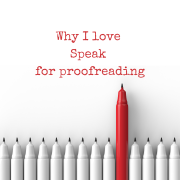Why I love Speak for proofreading
If you’ve ever tried to proofread the gazillionth draft of an article, you know it’s painful to reread a familiar piece. Plus, you naturally fill in missing words and correct other mistakes in your mind, not on the page. The Speak feature in Microsoft Word is helping me overcome this challenge. (Note: I initially used—and blogged about using—Adobe Acrobat for this purpose.)
Speak’s key feature is its ability to read documents out loud in a deadpan voice that makes mistakes and weak writing glaringly obvious, at least to me.
How to use Speak
For ease of use, add the Speak feature to your Quick Access Toolbar in Microsoft Word. The Speak icon is the white word bubble with the right-pointing green bubble in the image below.
Next, highlight the test that you’d like read aloud and then click on the Speak icon. Follow the text with your eyes as Speak plods through it. You may be surprised at what you discover.
I typically highlight one paragraph at a time, unless I’m confident that the piece is in excellent shape. If I make a lot of changes to a piece, I may review one sentence at a time.
Speak is particularly useful when I make heavy edits to client-written pieces because I might not realize that a change I made in one spot will require a corresponding change in another spot. I also find ways to streamline the writing.
How to use Read Out Loud in Adobe Acrobat
Before I upgraded to a version of Word with Speak, I relied on the Read Out Loud feature of Adobe Acrobat. Back then, I used it after converting Word documents to PDF documents. Today I use it when proofreading PDFs.
After opening my newly created PDF document, I follow these steps:
- Click on the Read Out Loud from the View Tab and choose Activate Read Out Loud. NOTE: The steps may vary if you have a different version of the software.
- Click on the text I’d like the software to read out loud. Usually I highlight one paragraph at a time for reading out loud as I follow along on a printed page. I am ready to click Shift + Control + C to pause the reading so I can type a correction or scribble an improvement on my hard copy.
- Input edits into the document.
- Repeat the Read out Loud process if I’ve made many edits.
I know I could read the document out loud myself. However, I’m impatient, so I usually give up after a few sentences.
Integrate text-to-speech into your process
I describe how I integrate Speak into my process in “12 steps to rewrite long articles.” Give it a try! If you need to develop more of a process for your writing—from brainstorming through distribution, check out my book, Financial Blogging: How to Write Powerful Posts That Attract Clients.
Note: I updated this article on Jan. 18, 2015; August 8, 2022; and Dec. 18, 2022.








Susan:
Adobe Acrobat Pro is a fine product, but let’s not endorse it simply for a feature that has been a free feature of Windows and Mac operating software for years.
Microsoft Word has had a read-aloud feature since 2004, and Mac computers have had it since the very first Mac in 1984.
The Windows feature is now called Narrator, and it’s been a feature of all Windows OSs since XP. On the Mac, the feature is called SimpleText. Both work in different languages, and let you adjust speed and voice quality to an extent.
Thanks, Phil! I wasn’t aware of this. I’m looking around my version for this feature. It seems pretty well hidden.
Sorry I missed your helpful comment until now.
I just learned about Speak in Microsoft Office: http://office.microsoft.com/en-us/outlook-help/using-the-speak-text-to-speech-feature-HA102066711.aspx#_Toc282684835
Hi.
The free Adobe Reader can read out loud too.
😉
Thank you, JR. I will update my post to reflect that.